Curry w/ Bengali Squash, Tofu, & Garden Peppers
I was at one of my favorite out of the way grocery stores perusing the fruits and vegetables the other day. Kind of looking for something fun to maybe turn into curry? I stopped by the ginger, almost picked up some red garnet yams, walked past the durian, wondered about a Japanese eggplant, thought about broccoli sprouts, and even contemplated dragonfruit.
But were any of these the mysterious curry flavor that I was looking for?
And then suddenly I came across something that I'd never seen before.
It was relatively large green gourd with lighter flecks of green. Some were round, like a large butternut squash. And some were long, like an enormous zucchini.
Whatever they were, I knew immediately that this was what I was searching for!
There was no indication of what it was. What you're supposed to do with it. How to cook it. Or what it tasted like.
But it looked like something fun to try out! And now I'm the proud owner of, as my receipt calls it, a “Bengali squash."
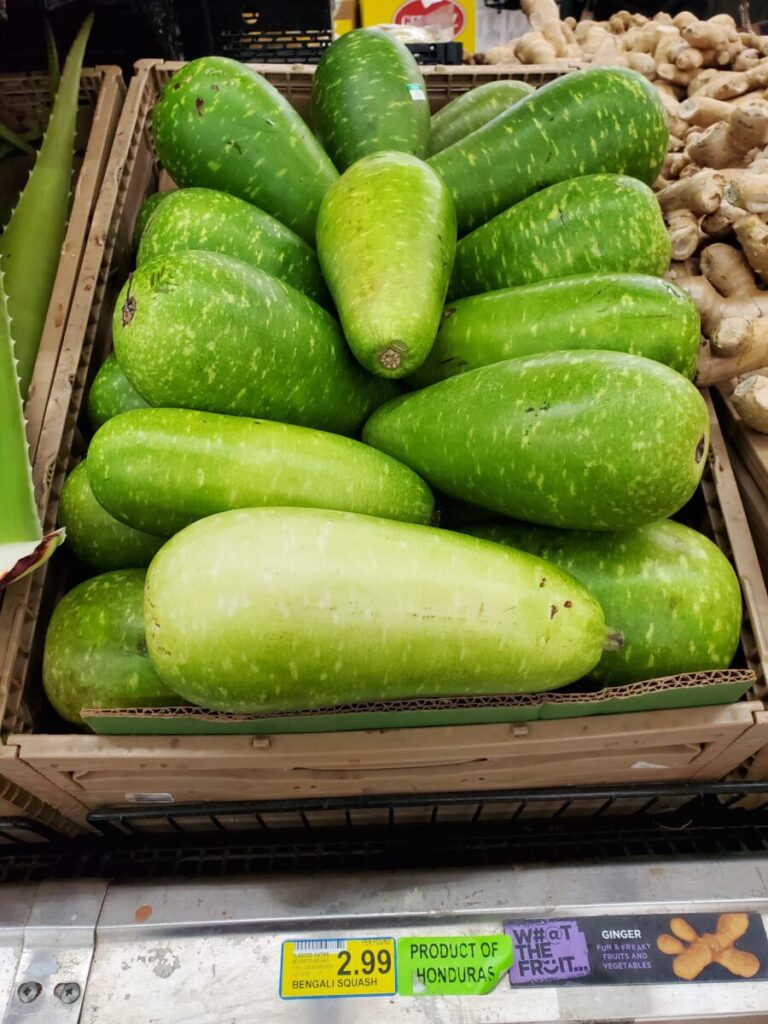
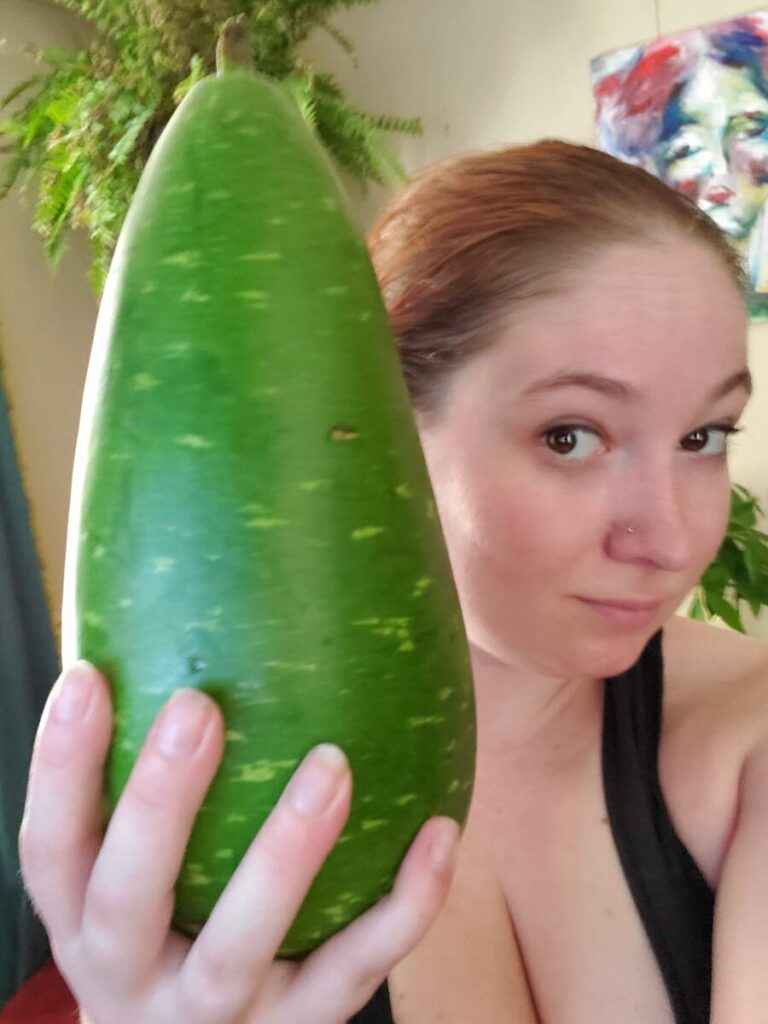
What IS a Bengali Squash?
Upon getting home with whatever a Bengali squash is, I started looking for recipes. The rough idea was curry or maybe stir fry. But, as always when cooking something new, I like to come into new recipes with a relatively open mind.
However, I came up with nothing. Even Googling “Bengali squash” came up with next-to-nothing.
It became clear very quickly that this was likely a generic term for something more specific. “Bengali kudu” came up more often. But “Bangla kudu/lau” seemed like the more authentic term. It translates to “Bangladesh pumpkin/gourd.”
Although this did explain my Googling problem. Calling it merely a squash from Bangladesh is likely why I was having trouble finding a recipe with it! Search results just ended up with Bangladesh recipes with squash in them and not specifically recipes with the squash that I was looking for.
Searching for “Bangla Kodu or Lau” warranted a few more results.
However, it still gave no greater insight as to whether it was a squash, a pumpkin, or gourd and… you know, what to put it in or how to cook it!
I generally think of gourds as being decorative not quite-so-edible. Both gourds and pumpkins are types of squash. Gourds are typically grown for ornamental purposes and tend to have harder shells and not have much as much flesh or seeds. And pumpkins can be for either ornamental or cooking, depending on the variety.
Whatever it was, I had been staring at this Bengali squash for far too much time. And, right or wrong, I was envisioning a large, green butternut squash.
I was also starting to assume (err hope!) that maybe the gourd-looking ones may have been more decorative and the massive zucchini one that we brought home was more for eating.
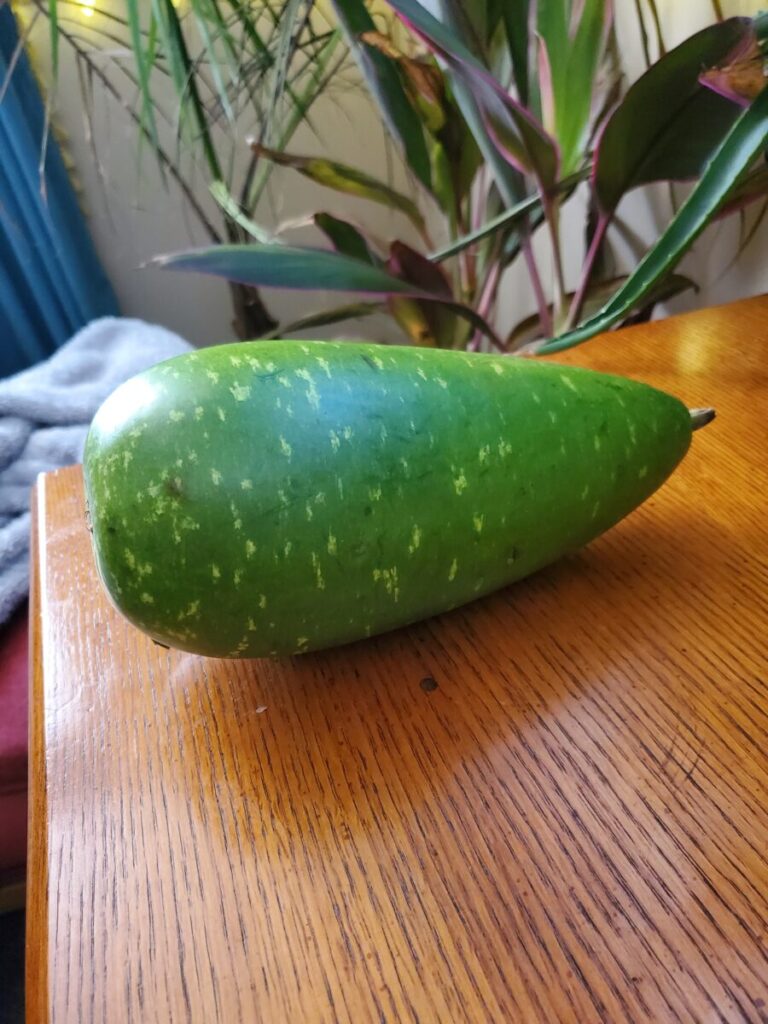
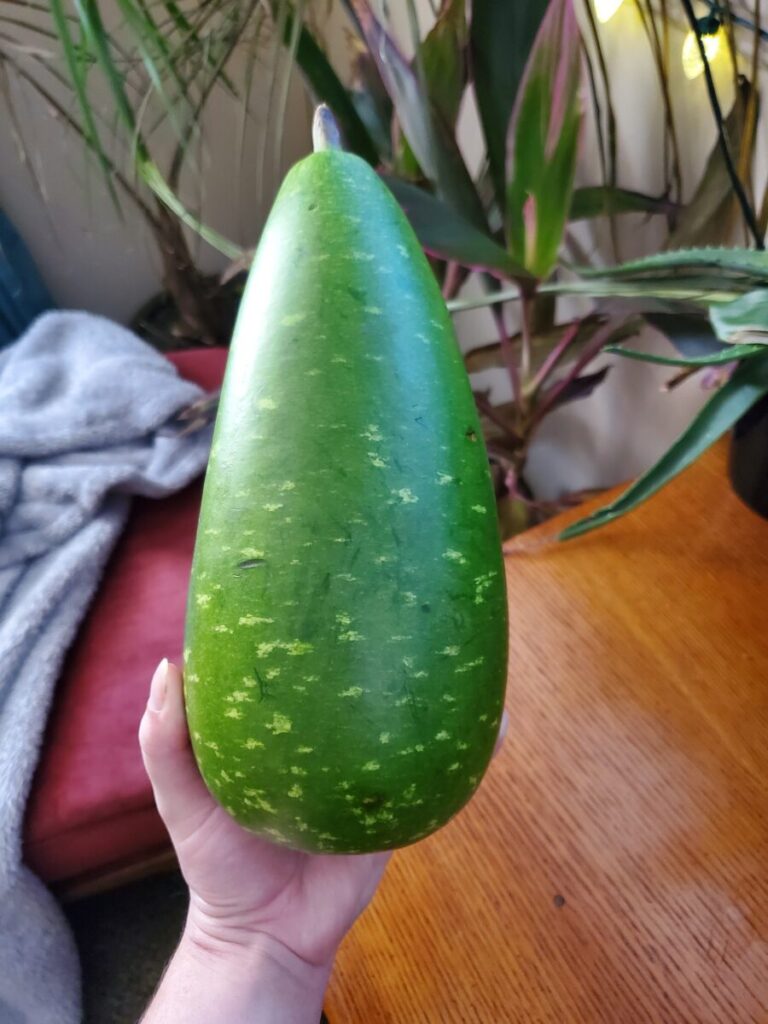
Can I Make a Bengali Squash Curry with This?
Ever more determined to make curry, I persevered.
Most Bengali recipes called for panch phoran, so I decided to begin there. Panch phoran is a Bengali five-spice made up of equal parts fenugreek, nigella seeds, fennel seeds, cumin and mustard seeds. A lot of recipes also added coriander, turmeric, and bay leaves.
Now, I'm not entirely sure how authentic these recipes are. However, after going down much more of a culinary rabbit hole than I had originally intended to and having most of these spices, it was time embark on the journey!
Since Bengali cuisines are also known for fish and lentils, it did seem fitting to make lentil curry with coconut milk and fried tofu.
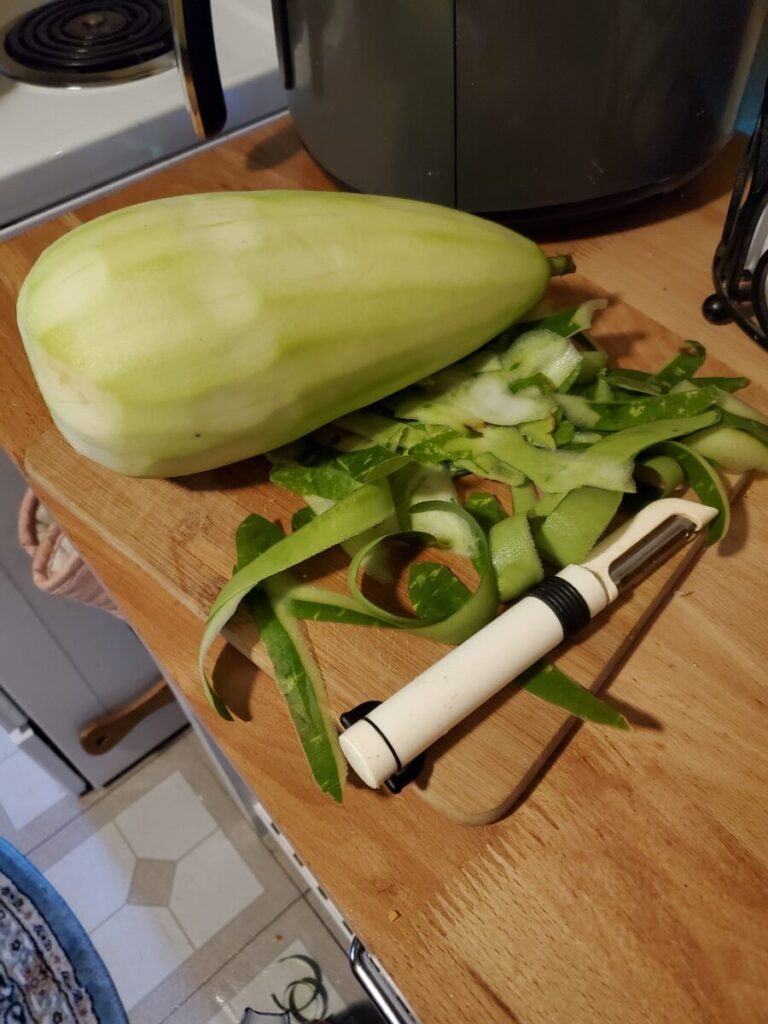
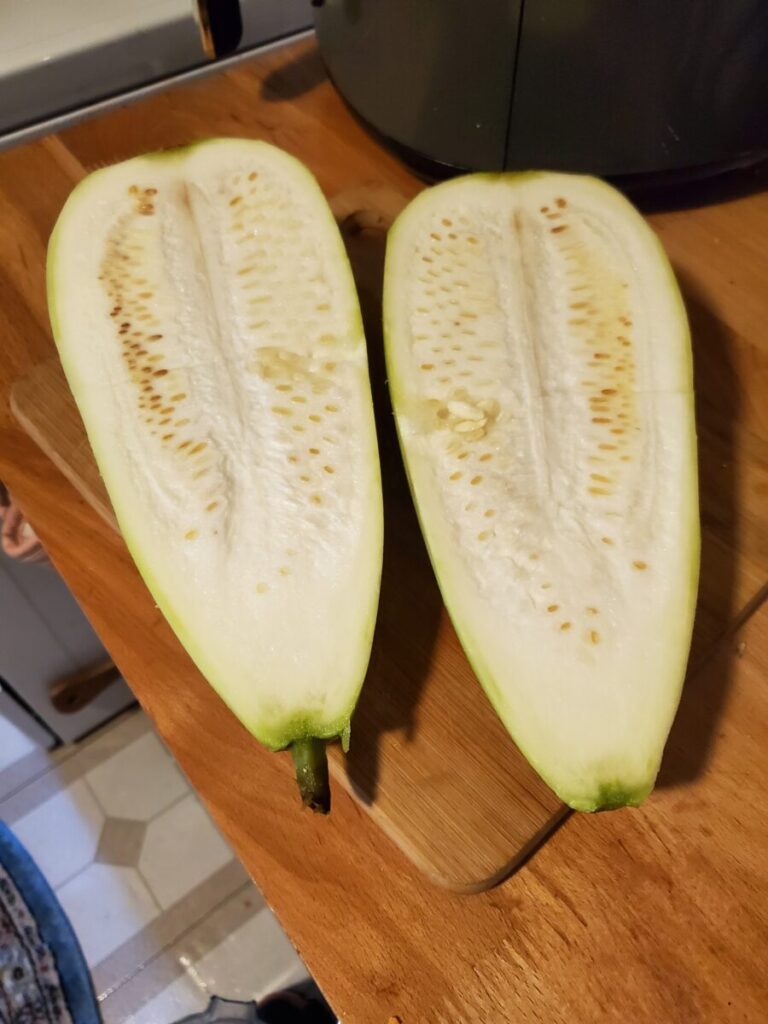
The Moment of Truth: Breaking Into the Squash
The next step was cutting into my squash and figuring out what exactly it was!
I decided to peel the squash. After all, a lot of the skin of pumpkins and gourds isn't edible. And then cut it in half.
To my surprise, the inside was soft! It was more like a zucchini than a butternut squash.
I even tried a bit of it. I wouldn't ordinarily recommend eating something that you don't recognize. However, summer squash are edible raw. And, upon breaking into this, it was very clear that it wasn't a winter squash, as I had been thinking!
Like many larger summer squash, it had a diluted flavor and tasted like a slightly sweeter yellow crookneck squash. I'm sure that it would be delicious chopped up in a salad or sliced on a sandwich.
The only thing to do next was to dice up the squash, pick some produce, and proceed to slowly simmer curry over the next several hours.
Gallery
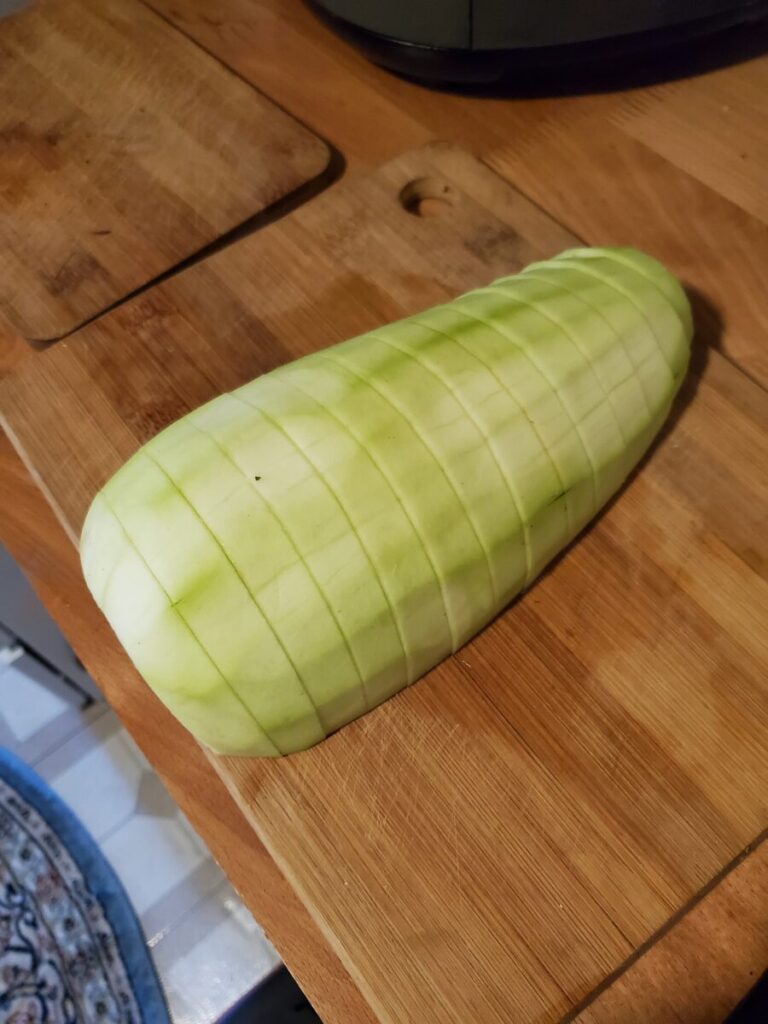
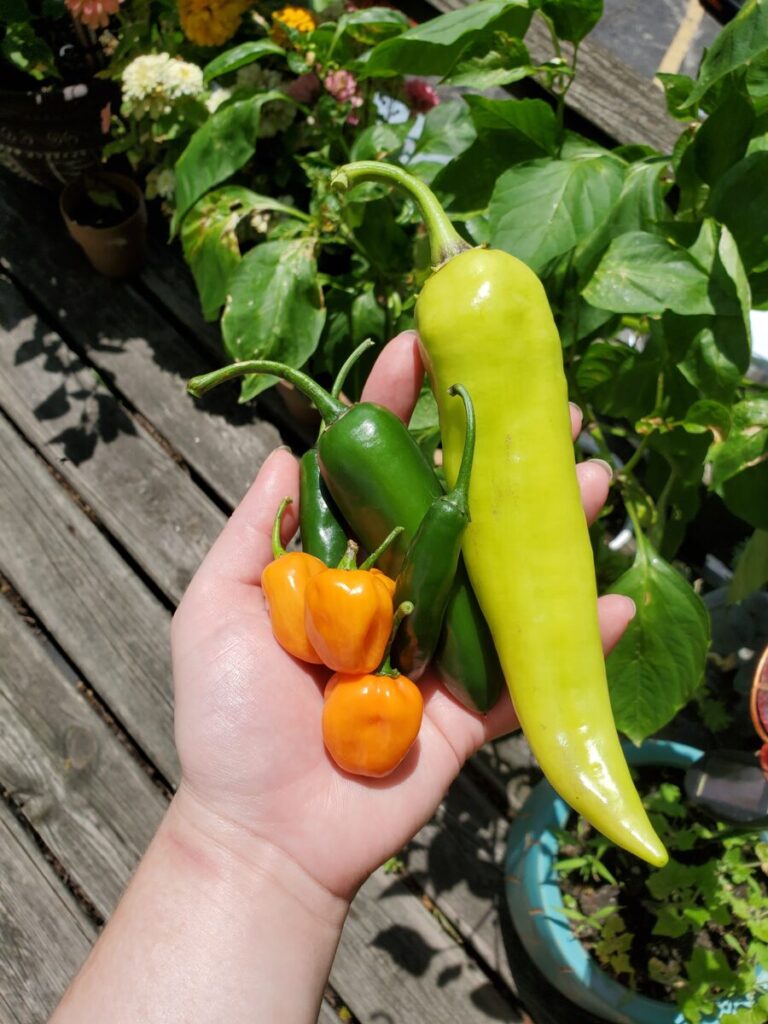
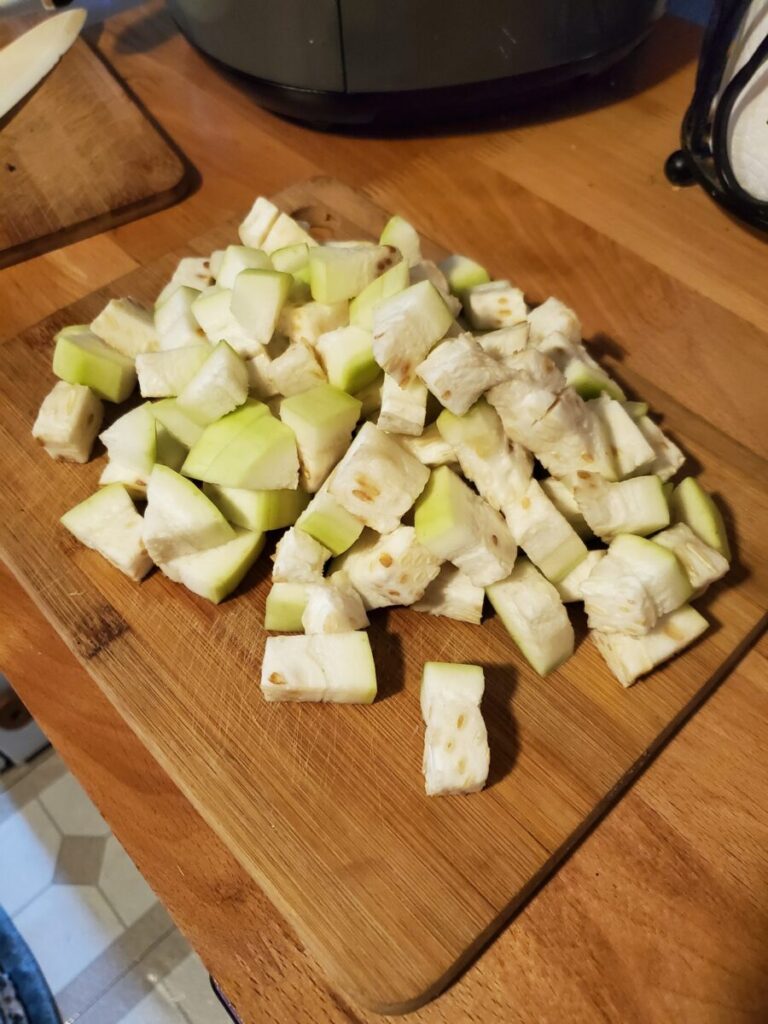
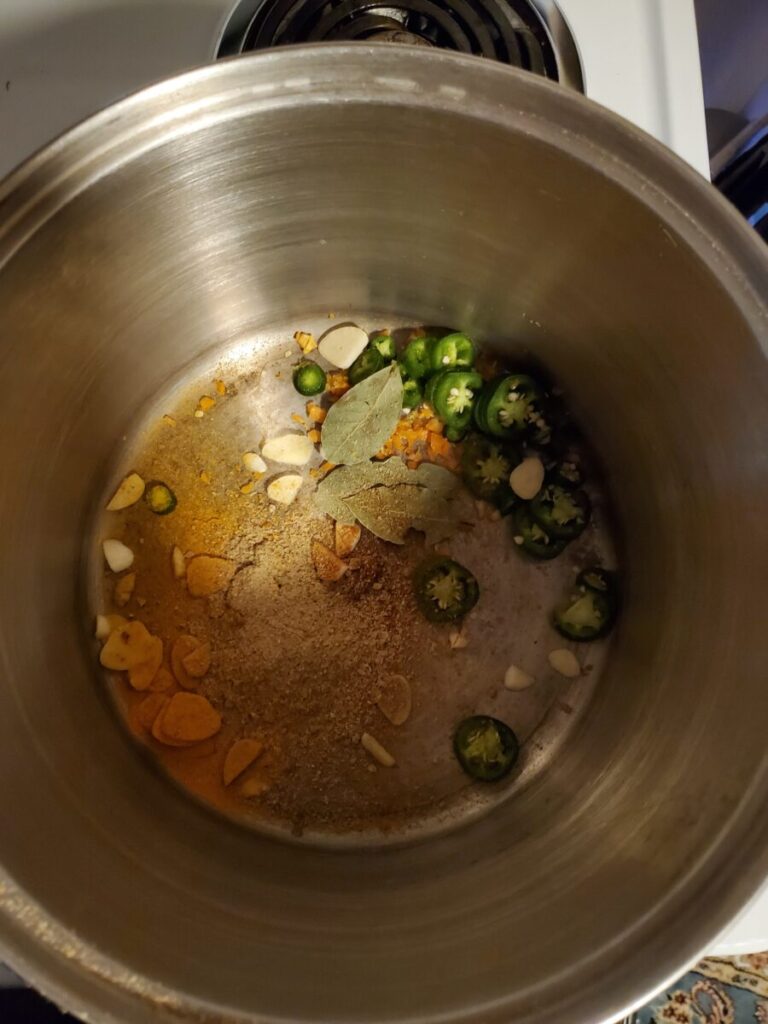
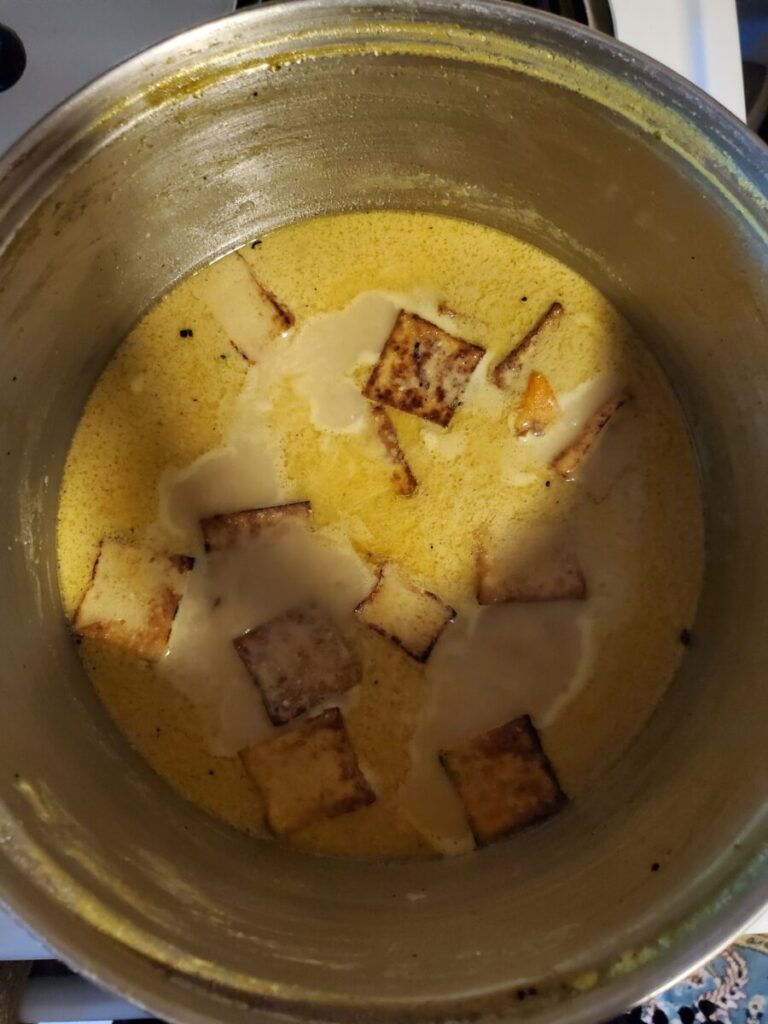
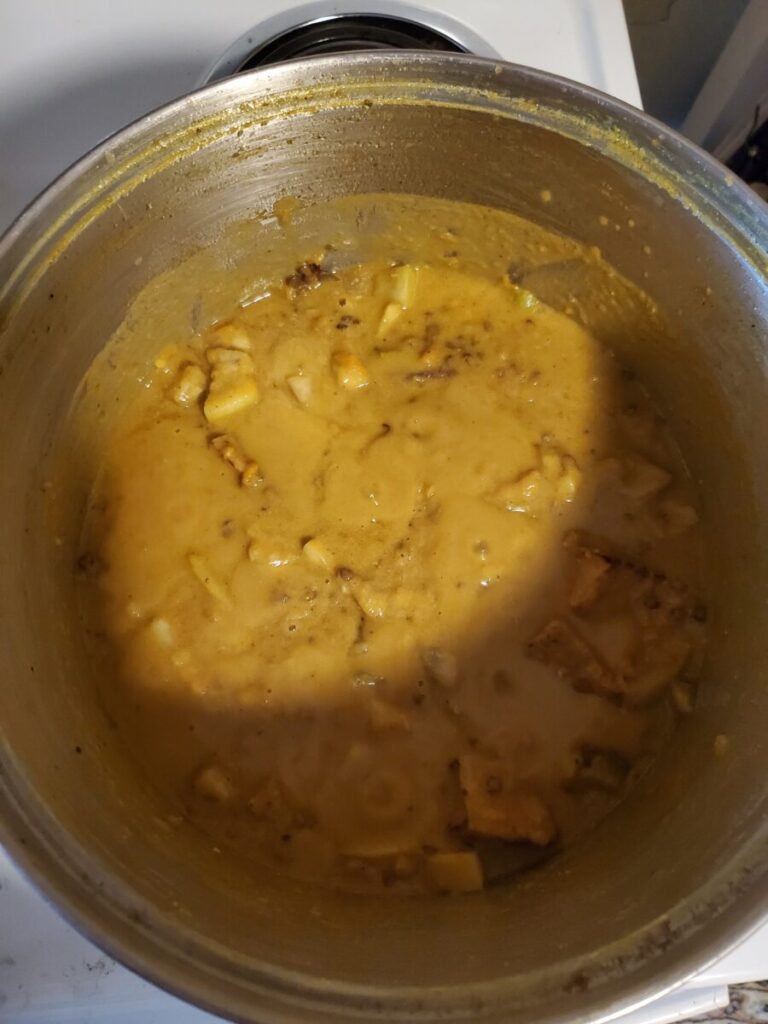
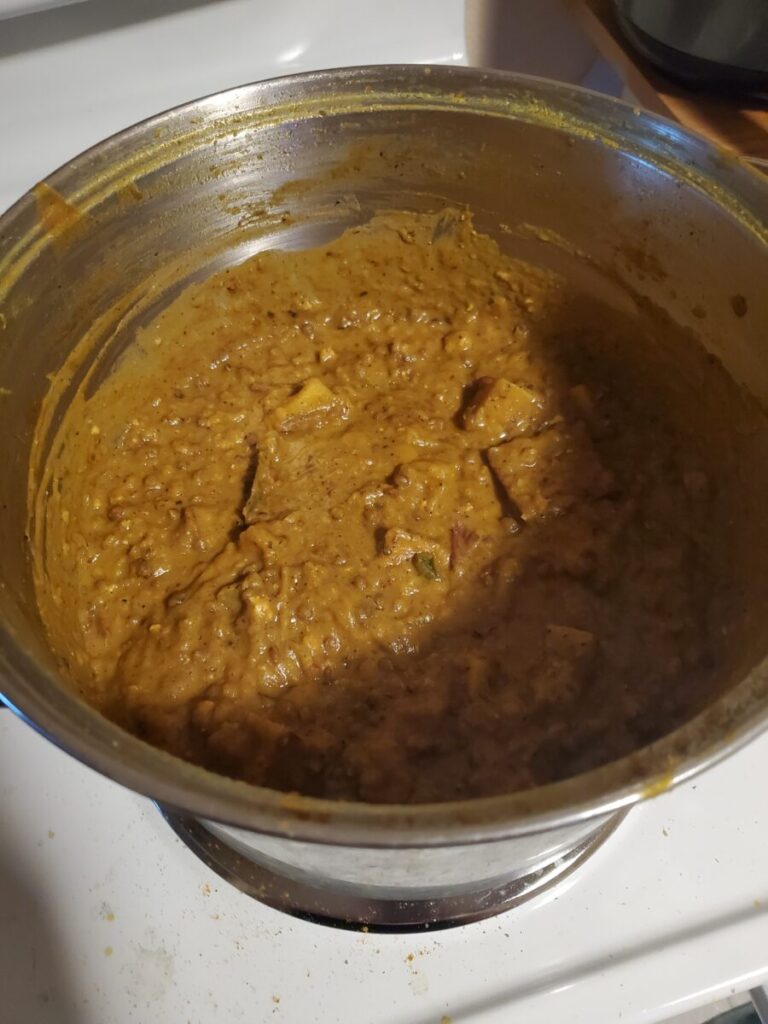
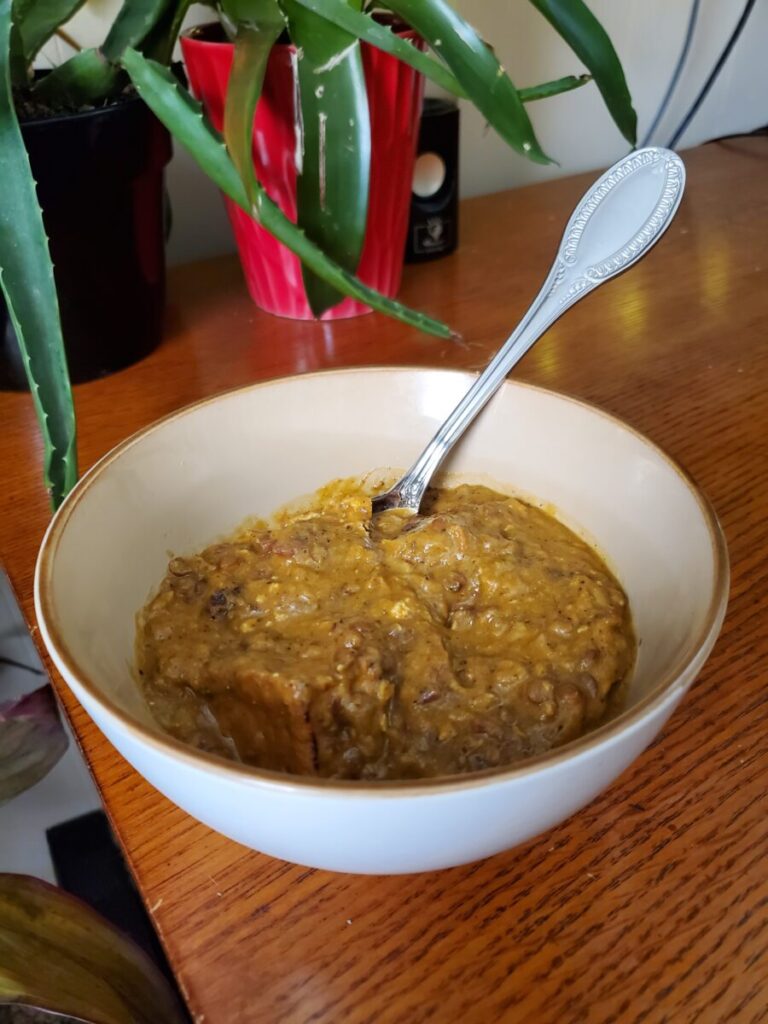
Variations of Bengali Squash Curry
Overall, I am quite pleased with this Bengali squash curry! I'm not entirely sure why more recipes don't exist out there. I suspect that it's because the squash is very light and could be easy to overcook in a slowly simmering recipe. But I found the bright and crispness added a great flavor profile to the mildly spicy curry.
There are also several different variations of curry that I've been making lately. There are plenty of fun squash and other produce out there to have fun with.
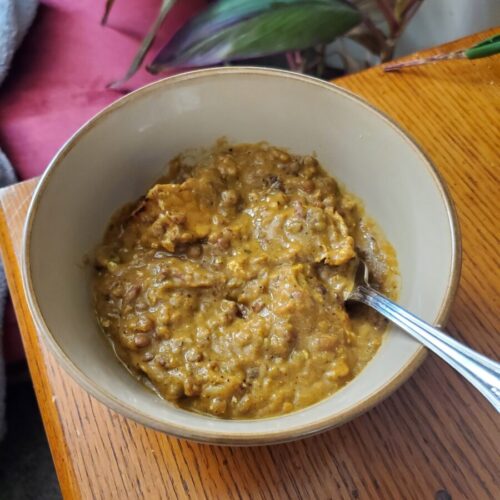
Curry w/ Bengali Squash, Tofu, & Garden Peppers
Equipment
- Large Pot
- Skillet (preferably cast iron)
- Stovetop
- Paper Towels
Ingredients
Produce
- 4 habaneros minced
- 2 serranos sliced
- 1 jalapeño sliced
- 1 banana pepper sliced
- 3 cloves garlic minced
- 1 tbsp. ginger minced
- 1/2 shallot minced
Spices
- 1/2 tsp. cumin
- 1/2 tsp. paprika
- 1/2 tsp. fenugreek
- 1/2 tsp. coriander
- 1/2 tsp. turmeric
- 1/2 tsp. red curry spice
- 4 bay leaves
- dash salt to taste
- dash pepper to taste
Curry
- 3 cans coconut milk
- ~6 cans water
- 1 lbs. tofu cubed
- 2 tbsp. high heat oil
- 1/2 c. Bengali squash (or other pumpkin or squash of choice), diced
- 3/4 c. French green lentils
- 1/2 c. red lentils
Instructions
Simmer Peppers and Spices
- Mince, slice, and dice the habaneros, serranos, jalapeños, banana peppers, garlic, ginger, and shallots. Add to a large pot.The hot peppers are entirely optional. Add or subtract to your own taste! I enjoy a hotter curry, though.
- Add coconut milk, water, and all of the spices (cumin, paprika, fenugreek, mustard seed, coriander, turmeric, red curry spice, bay leaves, salt, and pepper).It helps if you grind your own spices, but feel free to use what's available to you. If you're having trouble finding them, specialty Asian grocery stores often have more ingredients than local grocery stores as well as whole spices if you have a spice grinder or mortar and pestle. Otherwise, you can easily substitute more red curry spice or a red curry paste.
- Bring to a boil and then reduce to a simmer. On my stove, this is about a 2-4 setting. Although different ovens will vary in what a simmer looks like.
- Simmer for at least 2 hours. You want the liquid to reduce in half. If it’s reducing too quickly, add water and turn down the temperature. If it isn’t reducing fast enough, bring to a boil again and reduce to a slightly higher temperature.The longer that you cook, the more the flavors will permeate the ingredients, so simmering at a lower temperature for longer is always an option. I’ll sometimes lower the temperature to a very light simmer and pretty much leave it be for 6-8 hours.You never want to leave a pot on the stove unattended, but this is the kind of dish that you can kind of set up and let do its thing. You may need to turn the temperature down periodically to adjust for too rapid a simmer to keep it from boiling as the liquid evaporates. But, other than that, this is a pretty hands off dish!
Fry the Tofu
- After the curry has reduced about in half, you're going to want to add the tofu so that it can absorb the flavors. You can either put them in as is to reduce the oil in the curry or crisp the edges to help the tofu keep its shape. For this recipe, I lightly fried the tofu.
- While the curry is simmering, drain the water out of the tofu and cut into cubes.
- Wrap in paper towels to absorb the moisture.It's important to absorb as much water out of the tofu as you can. Oil is less dense than water, so the molecules repel one another. With cold ingredients, this causes separation. When you're frying at high temperatures, though, this can cause boiling hot oil to spray back at you.
- Meanwhile, preheat 1-2 tablespoons of oil in a cast iron skillet over medium-high heat.
- When the skillet has preheated and the majority of the water has absorbed into the paper towels, carefully add the tofu to the skillet. Fry until golden brown. This should take about 2-4 minutes. Rotate until all sides are evenly fried.
- Remove from heat and wrap again in paper towels to absorb the excess oil.
- Add the tofu to the curry and simmer for another hour or two.
Cook Squash and Lentils
- After simmering the curry for at least 4 hours and the curry is just about simmered down, add the squash and lentils.I tend to mix my lentils. Red lentils have my favorite taste, but they’re softer and tend to thicken recipes as they dissolve if you cook them for prolonged periods of time. I like to add a firmer lentil that keeps its shape, like French green, to add some bite back in. I added 1/2 cup red lentils and 3/4 cup French green lentils. But you can easily substitute any lentils, rice, or noodles at hand. Just cook to the manufacturer's recommendation.
- Simmer for another 30 minutes, stirring occasionally.
- Serve either immediately or the next day. Just make sure to remove the bay leaves serving.Curry will continue to the absorb the spices the more time passes. It’s one of those dishes that I like to make ahead of time because it often tastes better after the flavors have had time to set overnight.
Tips, Tricks, & Notes
- To make the curry spicier, put more hot peppers when you cook the squash and lentils. Peppers added in the beginning stage will have a slower, more robust flavor that permeates through the dish. Peppers added towards the end of the cooking process will have more of a kick in the teeth, mouth burn.
- If the lentils absorb too much moisture, you may need to add more water. This is to taste. I tend to like a thicker curry with larger chunks, much like a thick stew. If you’re in the other camp that likes a more liquid curry, don’t hesitate to add more water. It will be absorbed by the lentils. If you’re unsure, taste periodically and adjust to what you like. You can always add more water, even after you’re done cooking entirely, to lighten it up. The curry will thicken more as it cools and overnight.
- If you’re using coconut cream, instead of coconut milk, roughly cut the amount of cream in half and double the water. The main difference between coconut milk and coconut cream is that coconut milk is watered down, while coconut cream is thicker. Depending on the brand, it might be a solid chunk, like butter, and you’ll need more water. For other brands, it might be a liquid, and you’ll need less water.
- The general rule of thumb is that you want to slow cook the curry for at least 4 hours and cook out about half of the liquid. So, really just add enough coconut to taste and add enough water to cook down. If you’re unsure of how much to add, you can always add less water and keep adding as needed.
- Do you need whole spices? It’s best to grind the spices whole, if you have them whole. If you don’t, no worries. I had cumin, fenugreek, and mustard seeds whole. If you only have pre-ground spices, you just might need to add more to reach a more robust flavor. You can always add more seasoning to taste, so adding some in and hoping for the best isn’t the worst strategy. A lot of recipes also add nigella seeds, fennel, and coriander. This wasn’t exactly the flavor profile that I was going for, so I omitted them, but they do appear to be more traditional in Bengali dishes.
- If you’re not sure how much spices to add, I like to use the smell test: once you’ve added the coconut milk and started cooking, walk outside. Breathe in some fresh air. And then walk back inside. There should be an immediate smell of curry! If after about an hour, your whole house doesn’t smell like curry, add more spices!
- If you don't like the stringiness of ginger, you can zest or blend them. I love the taste of ginger, but don’t like the stringiness. So, I’ll mince the ginger and then add it and 1 can of coconut milk to a food processor and purée on high until the ginger is pulverized. This essentially makes ginger milk. It won’t be that strong a flavor to begin with, but the ginger will become more apparent as it cooks down.
- Do you need to sauté the peppers? A lot of curry recipes want you to sauté or otherwise cook vegetables beforehand. The first direction is typically, “sauté onions and peppers in oil on the stove.” I tend not to do this because it tends to mean adding oil to the curry. Since you’re simmering down for several hours, the natural oils in the vegetables that you use will separate. This will create a film of oil on top of the curry. Some people like this. It can also be an indicator of how spicy a curry is sometimes because the more peppers that you use, the more oils will naturally leach out of them.
- I don’t tend to find oily curry appetizing, though! So, I try to minimize the amount of added oil is in the recipe. If you’ve ever had a soup or sauce that’s separated, you know what I’m talking about. The oil will separate and settle on the top because it’s less dense than water. It will be obvious if it’s a problem.
- If you do end up with too much oil, add an ice cube or a frozen metal ladle to draw out the oil. Then, just spoon it out until you have removed enough oil. Alternatively, if you refrigerate the curry, the oil will rise to the surface. This will create a semi-solid chunk on top and you can spoon it out. If there’s a lot of oil and it has solidified enough, you can sometimes just pick up the layer with your fingers and remove it this way.
- For a more in-depth article on preparing tofu, check out my article on The Fundamentals of Fried Tofu. High heat oil and a precise cooking temperature are important to keep the tofu from drying out or burning.
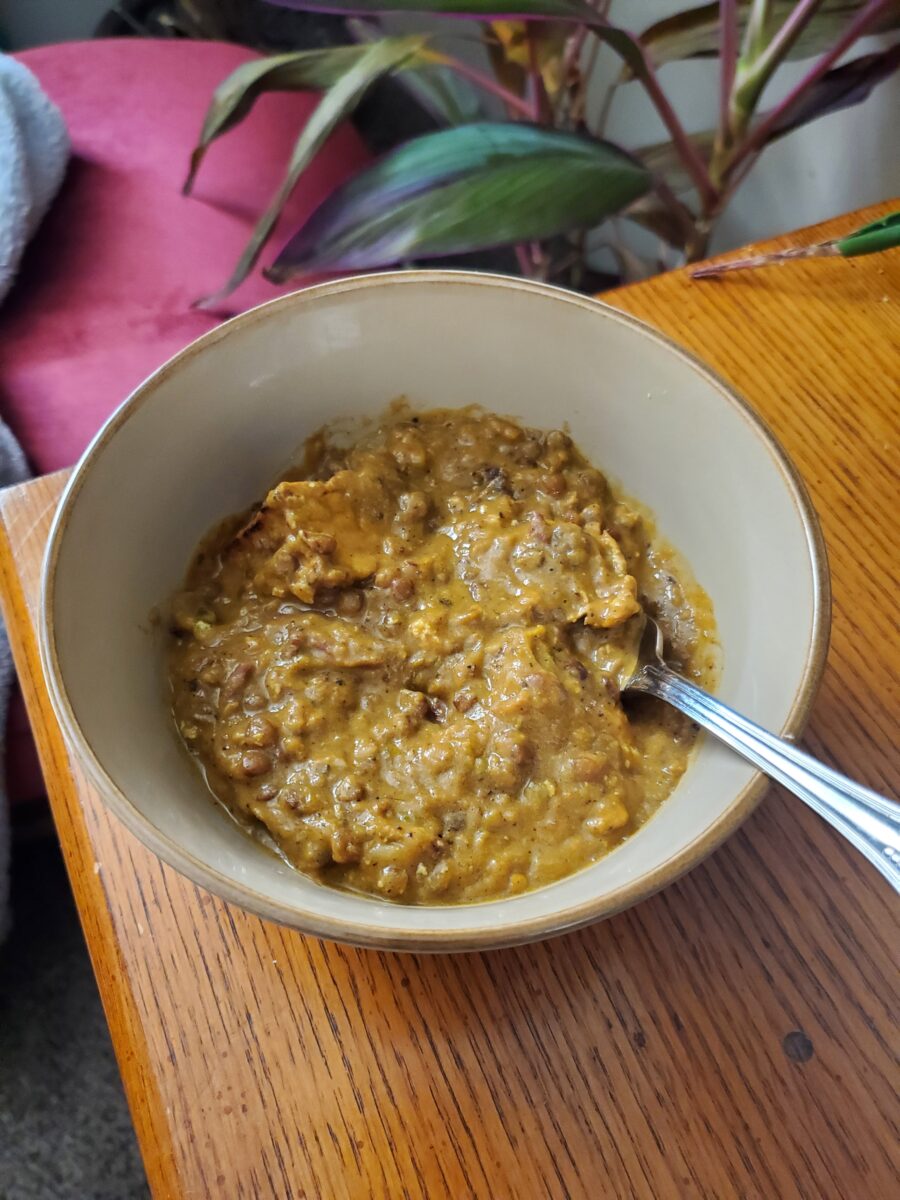
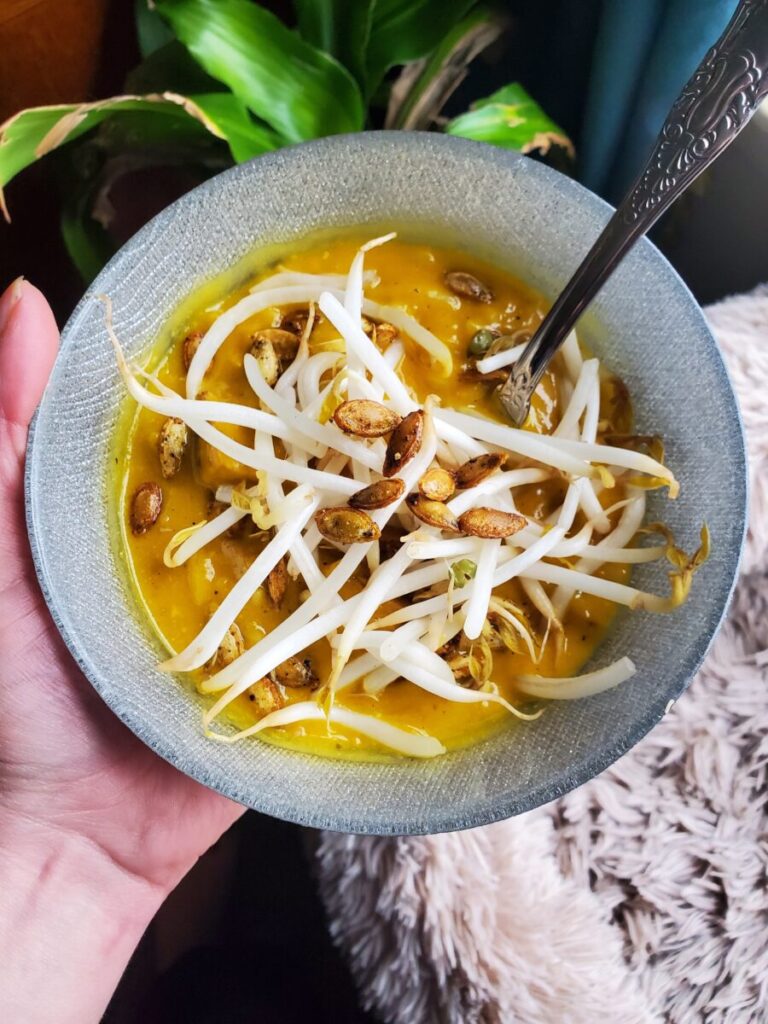
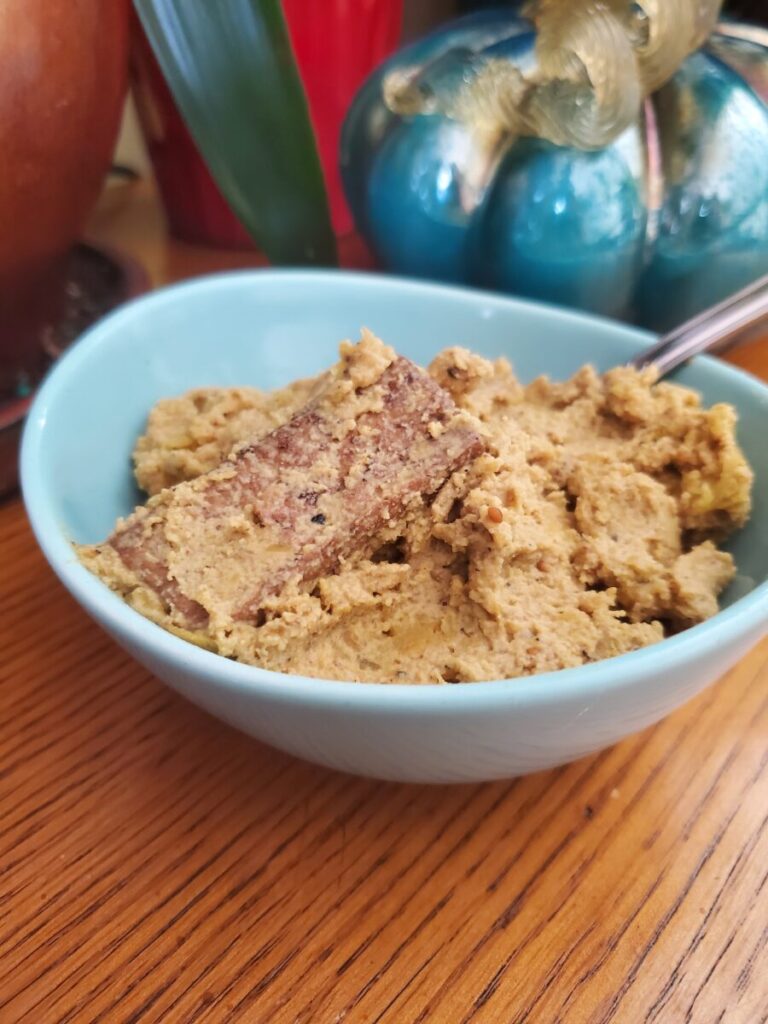
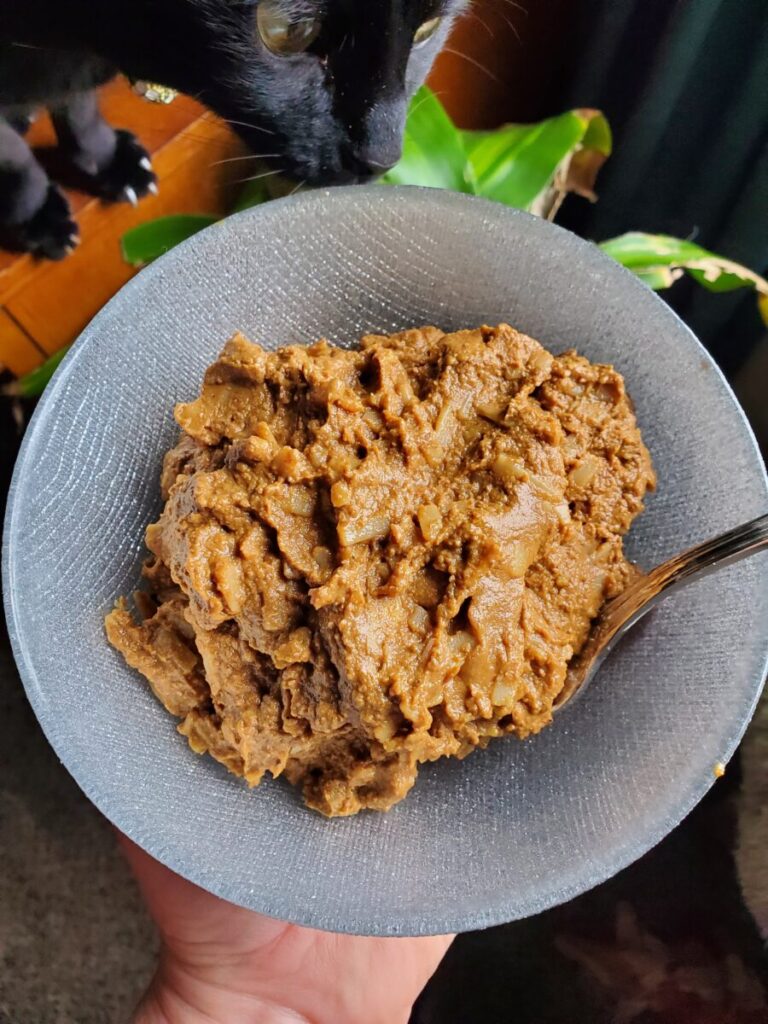


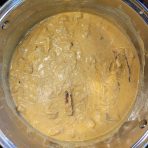
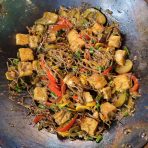

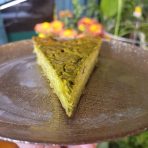

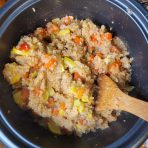
Cat
January 8, 2022 at 12:38 pmI had a similar experience yesterday — saw this unfamiliar produce at one of my favorite Asian markets yesterday, simply labeled “Bengali squash,” and threw it in my cart for a chance to try something new. “I’ll Google it later,” I thought. As you said, Google was basically no help, but at least it led me to your post, so now I know what to expect what I cut this thing open!
Catfish Out of Water
January 9, 2022 at 2:38 pmI’m so glad that someone else has stumbled upon this fruit! I went into this thinking that I was going to make curry, so I I obviously ended up making curry. Although I suspect that there are a lot of fun things to make with Bengali squash. It would work in just about anything that you would use a yellow crookneck squash for. But I’ve been really tempted to turn it into baba ghanoush or maybe even tzatziki… Let me know if you come up with something fun!